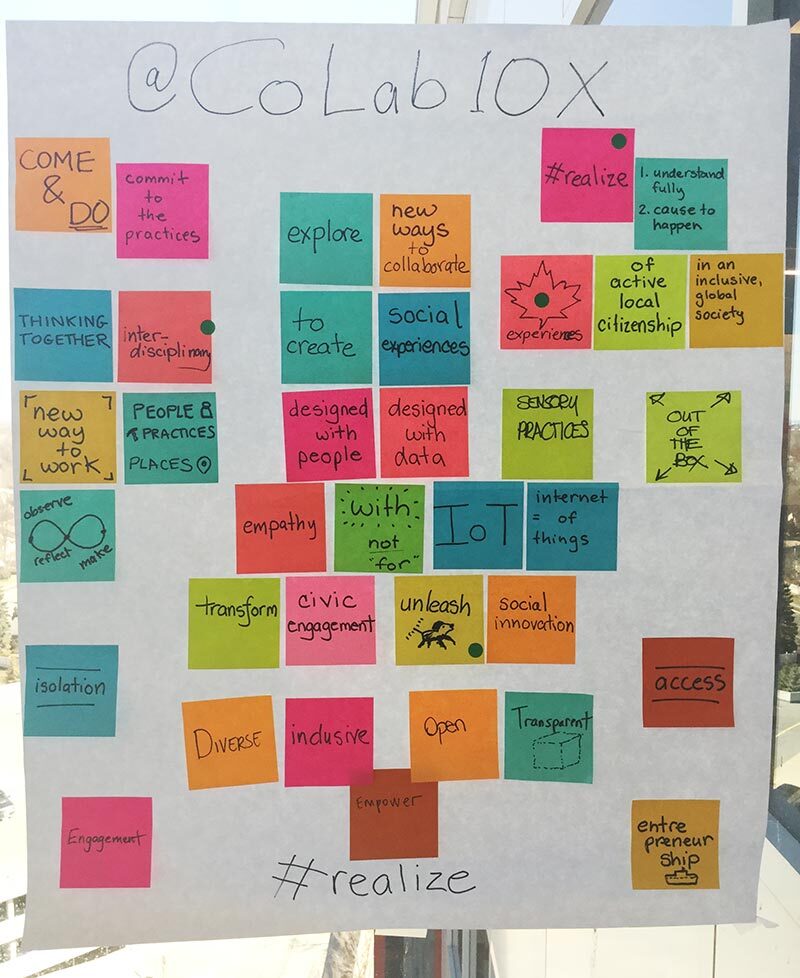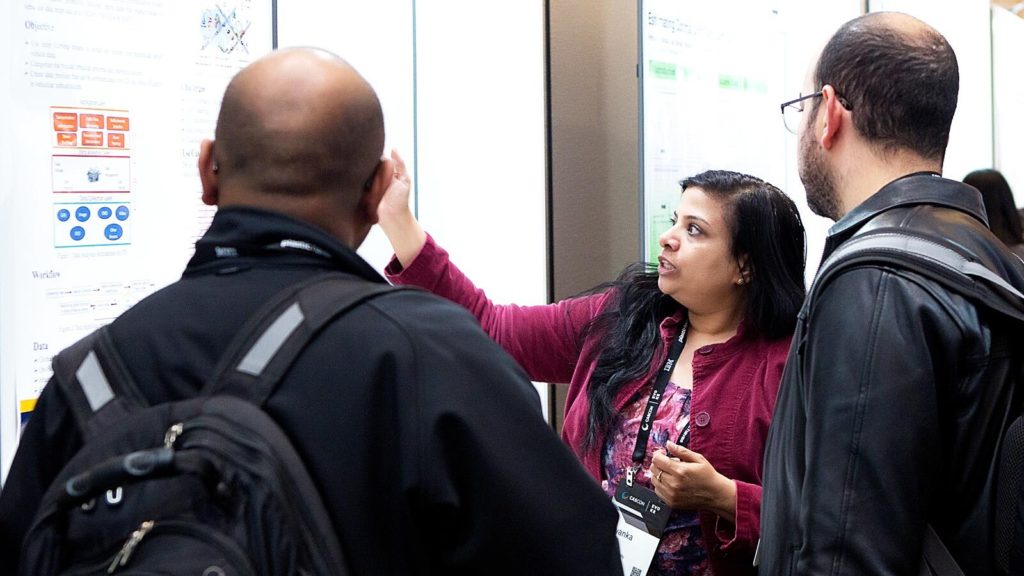IBM Canada’s Centre for Advanced Studies is weaving the perfect storm of innovation

The city council meeting starts with uneventful, routine opening remarks. Then all hell breaks loose, and the shouting begins.
“Our kids cross that street, and these crazy drivers fly up and down it like maniacs,” a mother of two young boys yells from the back, pointing around frantically at familiar faces.
“That isn’t possible with the unnecessary number of stop signs and lights already on that street,” a motorist fires back. “We don’t need a new crosswalk. It will clog things up even more.”
“You know full well you roll through those signs,” a concerned father chirps in response.
This situation is a hypothetical example that Marcellus Mindel calls a thought experiment. He’s out to prove a point about the effectiveness of traditional problem-solving techniques. Mindel, who is head of Advanced Studies at IBM Canada, says a design thinking approach can produce different, and often better outcomes.
“With a design approach, you first ask why the kids are going across the street,” he says. “Turns out, they’re going to after-school activities. And it turns out, there are already after-school activities on the same city block that would be better suited for the kids than crossing a busy street, they just don’t know about it.”
Mindel continues to iterate on possibilities and ideas in a rapid-fire manner as he runs through scenarios that might resolve the conflict in this fictional scenario. Through all of the ideation, however, he does not suggest a crosswalk is the answer.
If the after-school program is the reason the kids are crossing the road, that’s the users’ need. If they’re crossing because there isn’t a closer program, then the solution might be to instead design that.
“If a program doesn’t exist close to home, would the same money that was going to be spent on building a crosswalk be better spent creating a new afterschool program on the same block?”
There are multiple solutions to the same problem, but considering the end-user is key to an ideal problem-solving approach.
“I believe this kind of approach can get us to find other ways to solve problems rather than using hierarchy and politics to drive solutions,” he concludes.
How Enterprise Design Thinking unlocks innovation

The approach Mindel is referencing is called Enterprise Design Thinking.
Design thinking seeks to address problems by framing the issues in a human-centric way by putting the end-user at the center of all decision-making.
Enterprise Design Thinking puts the process into context in a business environment.
Originally developed by IBM in the early 2010s, Enterprise Design Thinking is a framework that seeks to take the agility and innovation found in smaller startups, and make it possible to achieve within large enterprises where multiple departments and teams of people participate in design exercises. It aims to solve users’ problems by catering to the often ambiguous nature of enterprise-level projects where dispersed teams collaborate on big projects with the focus on user outcomes.
And the results of the approach are impressive. Forrester research says that teams who take an Enterprise Design Thinking approach are 75% more efficient, and can turn out products twice as fast.
How design thinking works in practice
To provide an example of how design thinking works in the practical world, Mindel shared a story of a student at Carleton University who wanted to reduce the amount of disposable hot beverage cups that were being used at a campus coffee shop.
With a design thinking process, the first step was to empathize with the students to understand what they were doing, saying, thinking, and feeling, rather than just demand they stop using the cups.
Through the process, they learned that the students sleep in, rush to class, or they’re over-tired from studying. As a result, their to-go coffee mug is often dirty, sitting on their car floor, or at the bottom of a morning commute bag.
These students do indeed care about the environment, but user needs were simply getting in the way of the goal of reducing waste.
By looking at user needs and asking questions, Mindel says the group stumbled upon a “wow” moment and solution: What if the coffee shop put a washing station in the line so to-go mugs could be reused and cleaned on the spot, removing the barrier to why reusable mugs were not being used in the first place?
“In hindsight, it is absolutely, totally mind-blowingly obvious. And where I got excited about all this stuff, is that it helped me to rethink what innovation actually means.”

Advancing enterprise innovation
Mindel started his career as a software engineer in Ottawa, and later took on a number of roles managing relationships with academic institutions and research and development labs, before becoming head of the Canadian IBM Centre for Advanced Studies in 2015.
After joining, Mindel began learning more about Enterprise Design Thinking, and the problem-solving and innovation framework lit a fire in him as he looked to lead teams to innovate in new ways.
“What good are improved means, to unimproved ends?” Mindel asks, referencing a famous Henry David Thoreau concept. “A lot of technology research today is about improving the means without asking the question about the ends.”
Asking questions, and looking at “the ends” is what he spends every day doing as the leader of IBM’s Canadian Advanced Studies team, one of several in a global network that specialize in collaborative research. Today, Mindel leads partnerships between students, educators, and researchers who apply IBM technology to business and societal challenges.
How WeaveSphere became a design thinking epicenter
Creating innovation that matters within a large enterprise is no small task. If you find yourself scratching your head, unsure where to start, your first stop should be the Weavesphere technology conference.
Taking place November 15-17, 2022 in Toronto, WeaveSphere brings together world-class leaders and researchers from a range of disciplines who share insight, ideas, and co-create technology for the future.
The event is hosted by IBM’s Centre for Advanced Studies, and Evoke, and it invites everyone — even non-technical people — to attend. Attendees include undergraduate and graduate students, industry leaders, academics, IBMers, and anyone who wants to learn to leverage an enterprise design thinking approach.

The event is under a new name this year (it was previously called CASCON) but 2022 marks the 32nd year IBM’s Centre for Advanced Studies has hosted an industry-leading, award-winning technology conference.
Unlike other technology conferences where audiences sit passively and listen to keynotes and panel discussions, WeaveSphere attendees roll up their sleeves and jump head-first into the innovation pool. Researchers present ideas, industry leaders ask questions, students suggest new ways of approaching a challenge — whatever the scenario, it’s practical, and attendees walk away with ideas and real connections to build their future.
What makes the event so successful is how it brings to life the work that Mindel and his team do every day within Advanced Studies, while also inviting a bigger group to the innovation roundtable.
“What we are doing through Enterprise Design Thinking is creating ways to improve the ends, and the means,” Mindel says. “We seek to help people enter into a problem space when they don’t know what to do, or even what the problem really is, or how to solve it.”
He likens the approach to the story of Frodo, a character in Lord of The Rings. Frodo is a Hobbit who volunteers to lead the dangerous, long journey in order to deliver a valuable and important asset (the ring) to Mordor. Frodo doesn’t know the way there, and he is not the most obvious first choice to lead the journey, as there are many others who are braver, stronger, and more experienced than he.
In Advanced Studies, and at the WeaveSphere conference, there is an opportunity for anyone to lead and present their ideas to problems. In fact, Mindel says that when many Frodo-like people from a variety of backgrounds write their ideas on sticky notes and put them together on a wall, magic (and true innovation) happens.
That is the essence of WeaveSphere.
It’s an opportunity for everyone to get involved in the collaborative process of design thinking, and embark on their own journey into the unknown, to get to a faraway place, without a map.
Digital Journal is an official media partner for WeaveSphere. We will share updates leading up to the event, and we’ll be live on location from November 15-17,2022. Join us and get your tickets at
The post IBM Canada’s Centre for Advanced Studies is weaving the perfect storm of innovation appeared first on DX Journal.
